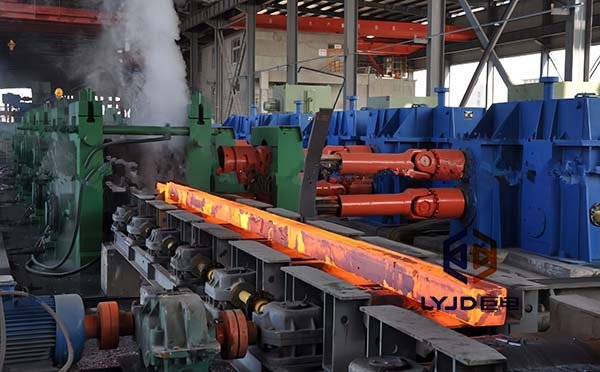Steel rolling line equipment
Check all bolts to ensure that the connection is firm and reliable.
Frequently observe the working condition of the thin oil lubricating oil flow indicator to ensure that the oil circuit is unobstructed, the oil pressure and flow are sufficient, and there must be no leakage in the pipelines, valves, seals, and joint surfaces.
Frequently check the working condition of the bearings. There should be no heat, looseness, severe wear, abnormal noise, etc., and problems should be dealt with in time.
Check the working condition of the gears to keep their transmission stable. Frequently open the observation cover to check whether the tooth surface contact and wear are normal, whether the flat grooves on the lubricating oil nozzle are unobstructed, and deal with problems in time.
Check the oil flow through the oil flow indicator at the entrance of each lubrication point. The on-site setting values are as follows:
Rough rolling reducer: pressure relay pressure ≥0.15MPa is normal.
Medium rolling reducer: pressure relay pressure ≥0.15MPa is normal.
Pre-finishing reducer: pressure relay pressure ≥ 0.15MPa is normal.
Check the temperature of the bearing (tile) seat by hand. If there is no hot feeling after touching the tile seat or end cover for about 3 seconds, it is normal. If the temperature is too high, report it to the workshop immediately.
Use a listening needle to touch the bearing (tile) seat and listen to the movement and sound. If there is no abnormal sound, it is normal. If the sound is abnormal, report it to the workshop immediately.
Daily inspection and maintenance
Equipment cleaning:
Regularly clean the dust, oil and debris on the surface of the equipment.
Keep the environment around the equipment clean and tidy to prevent foreign matter from entering the equipment.
- Lubrication system:
Check the oil quantity and oil quality of each lubrication point to ensure that the lubrication oil path is unobstructed.
According to the lubrication requirements of the equipment, regularly replace the lubricating oil or grease.
- Fastener inspection:
Regularly check the tightness of each fastener (bolt, nut, etc.) to prevent loosening.
For parts running under high load, pay special attention to the status of the fasteners.
- Electrical system inspection:
Check whether the wiring and terminals in the electrical control cabinet and distribution box are loose.
Measure the current and voltage of each motor to ensure that the electrical parameters are within the normal range.
II. Regular maintenance
- Mechanical parts:
Regularly check the wear of key parts such as rollers and bearings, and replace or repair them in time.
Check the wear of the transmission system (such as gears and chains) to maintain normal meshing.
- Hydraulic system:
Regularly check the quality and oil level of the hydraulic oil and replace it if necessary.
Check whether the hydraulic pipeline and joints are leaking and maintain the sealing of the hydraulic system.
- Cooling system:
Check the water quality, water volume and water pressure of the cooling water system to ensure the cooling effect.
Clean the cooling water pipeline regularly to prevent blockage and corrosion.
III. Troubleshooting and handling
- Equipment vibration:
If the equipment vibrates abnormally, first check the foundation tightness.
Check whether the bearings and couplings are worn or loose, and replace damaged parts in time.
- Abnormal noise:
Check the lubrication of mechanical parts. Poor lubrication will lead to increased noise.
Check whether gears, bearings, etc. are damaged and repair or replace them in time.
- Product quality issues:
If the product size and surface quality are found to be unqualified, check whether the roller gap and pressure are normal.
Check the synchronization of the transmission system and control system to ensure the stability of the rolling process.
IV. Annual maintenance
- Comprehensive inspection:
Carry out a comprehensive inspection of the equipment, including mechanical, electrical, hydraulic and cooling systems.
Record the operating parameters and status of the equipment and formulate a maintenance plan.
- Equipment calibration:
Calibrate key components such as rollers, transmission systems, etc. to ensure equipment accuracy.
Check and calibrate the parameters of the electrical control system to ensure control accuracy.
- Overhaul and upgrade:
Carry out necessary overhaul or technical upgrade according to the age and status of the equipment.
Replace aging and severely worn parts to improve the operating efficiency and life of the equipment.
V. Training and Management
- Operator Training:
Regularly train operators on equipment operation and maintenance knowledge to improve their skills.
Emphasize the importance of equipment maintenance and safe operation to avoid equipment failures caused by operating errors.
- Maintenance Record Management:
Establish detailed equipment maintenance records to record the content and time of each maintenance, maintenance and overhaul.
Analyze maintenance records, identify common faults and weak links, and improve maintenance strategies.
Through scientific maintenance and maintenance, the service life of steel rolling equipment can be extended, production efficiency can be improved, and the stability of product quality can be ensured.
The above is what we share today, and we hope it can help you. Welcome to Luoyang Judian, let us provide you with more services.
